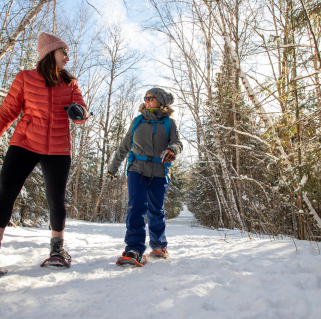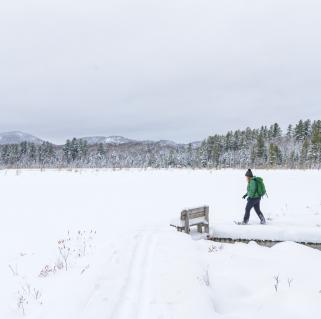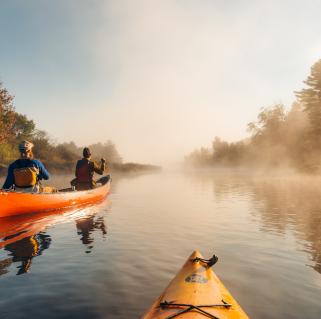Alan Belford
December 23, 2014
Heading to Scarface
It had been a little while since I had been there, so the other day Wren and I grabbed my snowshoes and headed to the Scarface Mountain Trail in Ray Brook. My usual choice for winter activity is cross country skiing. But, I often find that I am more observant of my surroundings when I’m on foot, since I’m able to take my time. This means I don’t have to focus on the terrain so closely, and that suited me fine since my goal that day was to take a few photos and look for animal tracks.
If you go to Scarface, the parking lot may not be plowed, but Ray Brook Road is quiet enough you can usually find a good spot along the road. The day was overcast and cold and the snow continued to cling to the trees as it had done for days. We haven’t had much warm sun or wind to shake it free and our way was constantly blocked by drooping trees or downed limbs. These were easily negotiated, but anyone who comes to the trail on skis should be mindful that the trail has quite a few roadblocks hidden by tight bends.
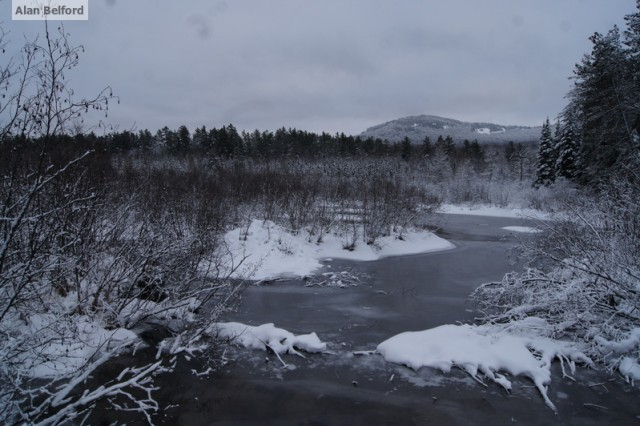
Tracking a Variety of Animals
We quickly began to find the tracks of both Snowshoe Hare and Red Squirrel and these were our constant companions the entire hike. The first two miles of the Scarface Mountain Trail cut through mostly coniferous forest which is a good habitat for both species. We reached the large wooden bridge and system of planks which crosses Ray Brook, and slowed our pace as we took our time to negotiate it. The trail and bridge were not icy, but all the packed down snow and open slots between the boards made the bridge a bit dodgy to cross. Wren is always leery of the bridge, even in good weather. Anyone who comes will likely find it easier to make the crossing without the hindrance of snowshoes or skis on their feet. We crossed without incident and as I climbed the short set of stairs on the far side a Red-breasted Nuthatch landed on a tree at eye level, perhaps 6 or 7 feet away. It sat quietly tilting its head and clearly assessing us with interest and I felt like I was being evaluated for some unknown purpose. Perhaps the nuthatch deemed us unsafe because it finally flew a bit higher in the tree and sat looking at us again as it began making soft calls. Perhaps it has been fed by people in the past and was hoping for a handout. It eventually flew off.
I didn’t note any beaver tracks near the bridge or the remains of the small beaver dam on the stream, but shortly after crossing Ray Brook we found a set of Red Fox tracks. We followed them a short distance off trail as a small group of Golden-crowned Kinglets and Black-capped Chickadees chattered overhead. Fox tracks came and went along the trail for much of the hike and many times they followed the trail for a spell before heading back off into the woods to hunt for Snowshoe Hare and other small mammals. The same was true of Coyote tracks, and we found piles of frozen Coyote scat as well. Human trails often make for easy wildlife travel, after all.

Finding Still More Tracks & a Black-backed Woodpecker
Not much further along the trail White-tailed Deer tracks intersected the path as well, and I also came across the tracks of American Marten. These were set in tandem as the tree climbing member of the weasel family hopped through the forest in search of food. They are good Red Squirrel hunters and I was hoping the marten may have caught a squirrel as I looked at a nearby squirrel midden – the place where the squirrels leave behind the remains of pine and spruce cones after feeding. It seems the marten wasn’t the only animal interested in the Red Squirrels, a short while later I found a set of Fisher tracks left where the animal loped through the snow. This one may have been interested in the Ruffed Grouse tracks I kept seeing near its own. The grouse – it was difficult to decipher if it was one or multiple birds – seemed to go back and forth zigzagging around the forest. The feet of grouse actually acquire small projections during the winter which act as snowshoes and this bird was using them to its advantage as it meandered through the forest on crusty snow in search of food.
It was one of the few signs of birds I found on the walk. In one spot a dead tree bore the gaping hole made by a Pileated Woodpecker and in another I heard the pik of a Black-backed Woodpecker call. While Black-backeds are known more as a bird of boreal forests, the forests on Scarface are coniferous enough to support them.

Not far from where I heard the Black-backed calling I reached the remains of an old house and as I neared the stream that marks the beginning of the climb up the mountain itself, I decided to turn around. I had been moving slowly as I probed the trail for tracks, and I wanted to hike out before it grew dark. Even with the snow covered ground, the light was dimming and I put my camera away and quickened my pace to make sure we crossed Ray Brook with plenty of light to see our footing. Wren raced ahead excitedly on our way out, pausing here and there for my slow pace to catch up. I was hoping that our timing in the evening shadows would allow us to see one of the mammals we had been tracking, but we weren’t so lucky on this walk. But even without seeing the animals themselves, snow tracking is a great way to witness the diversity of the Adirondack woods. As a result, it is one of my favorite activities on the winter landscape. We returned tired and happy from our hike.
As we drove through downtown Saranac Lake, we took our time choosing the perfect place for dinner. Need help planning your next winter snowshoeing adventure - we can help!
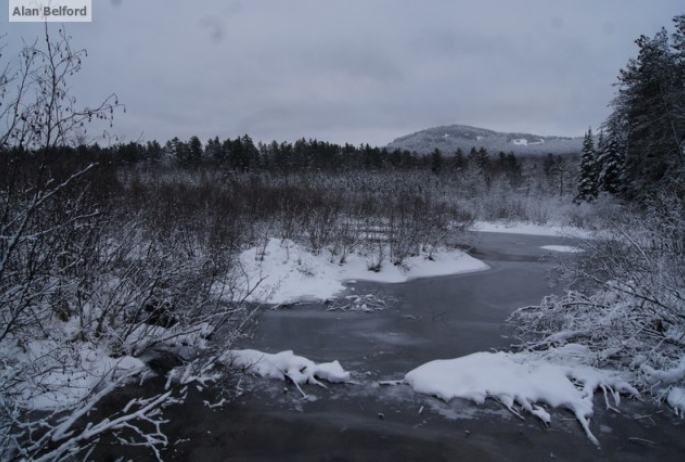
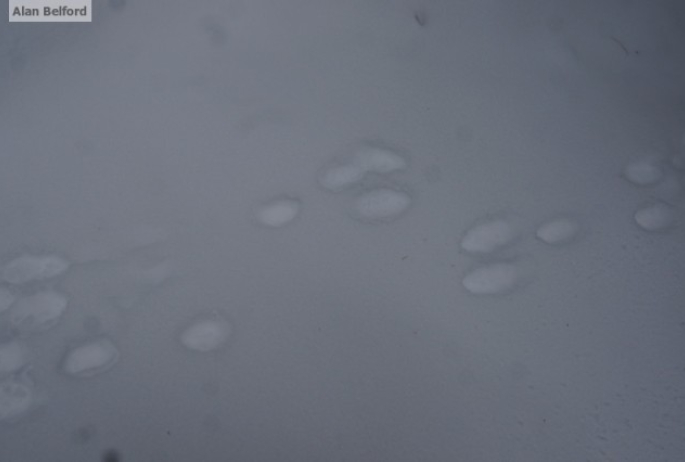
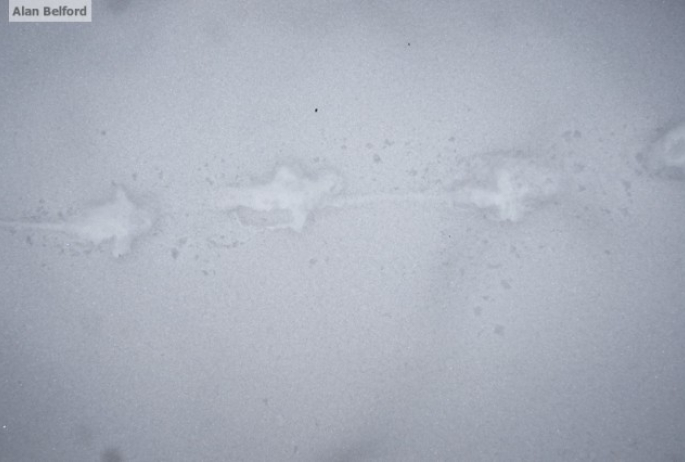
Packages and Promotions
Valid Jan. 16
- Mar. 31
Valid Jan. 16
- Mar. 31
Hotel Saranac Sled & Spoke Package
Hotel Saranac
Snowmobile Package Hotel Saranac and Sara-Placid Sled & Spoke have partnered so you and a guest can explore dozens of miles of ADK snowmobile...
Valid Jan. 21
- Mar. 31
Valid Jan. 21
- Mar. 31
Titus Mountain Ski Package
Voco Saranac Lake
Enjoy your stay at the award winning voco Saranac Lake which includes two adult lift tickets at Titus Mountain Family Ski Center. Additional...
Valid Jan. 21
- Jan. 21
Valid Jan. 21
- Jan. 21
Pet Getaway
Voco Saranac Lake
Your dog deserves an Adirondack getaway too. Book our pet friendly hotel near Lake Placid welcomes every member of your crew. Book our Pet Package...
Valid Dec. 1
- Dec. 1
Valid Dec. 1
- Dec. 1
Linger Longer in Saranac Lake
Best Western Saranac Lake
Linger Longer in Saranac Lake at our supremely located property, Best Western Saranac Lake. Stay 2 nights or more and get 15% off!
Valid Jun. 20
- Sep. 7
Valid Mar. 12
- Jun. 30
Guided Nature Immersions - 10% off for Pre-Season Registration
Adirondack Riverwalking & Forest Bathing
Picture it now...you are wading the Ausable River on a warm summer day, feel the cool water against you, hear the sounds of the birds and the...
Valid Jan. 21
- Jan. 21
Valid Jan. 21
- Jan. 21
Stay and Dine
Voco Saranac Lake
Receive a 50 dollar credit per stay to use in our Boathouse Saranac Lake Pub. Enjoy an exceptional dining experience with unparalleled views great...

